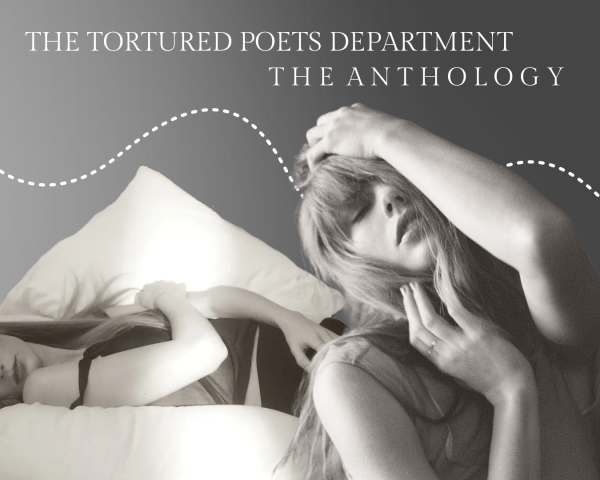
On April 19, American singer-songwriter and pop icon Taylor Swift released her 11th album “The Tortured Poets Department,” which consists of 16 songs — two of which are collaborations with artists Post Malone and Florence + The Machine. Within less than 24 hours after its release, the album garnered over 300 million streams on Spotify and became the most-streamed album on Spotify in a day. Two hours after the album’s release, Swift announced that the album was a secret double album, titled “The Tortured Poet Department: The Anthology,” bringing the tracklist to a total of 31 songs.
The opening track of the album, “Fortnight,” featured a music video that starred Swift, Post Malone and “Dead Poets Society” (1989) alumni Ethan Hawke and Josh Charles. The appearances of Hawke and Charles were particularly exciting for fans, given that Swift included their characters as members of her “Tortured Poets Department.”
“Fortnight” explores the spectrum of love, using black and white colors to signify contrasting portrayals, whereas the music video is shot entirely without color, alluding to lost love. Fans found the music video’s aesthetic fitting, resonating with the album’s theme of dark academia and its focus on poetry. Additionally, it showcased Swift’s creative prowess. The pulsing electro-synth bass of the song mirrors that of “Daylight” from her seventh studio album, “Lover” (2019).
The album takes a similar approach to lyrical storytelling methods as exemplified in “folklore” (2020), “evermore” (2020) and “Midnights” (2022). When she announced the album at the 66th Grammy Awards earlier this year, many fans speculated how similar the album would be compared to her previous ones. Swift has pulled off several genre shifts — from country to pop to folk, and now back to pop.
I found “The Tortured Poets Department” to be one of Swift’s most authentic albums to date. In every song, it is evident that she is drawing from her personal and private life, lending insight into her last few years. This blend is especially dominant in songs such as “So Long, London,” “imgonnagetyouback” and “My Boy Breaks Only His Favorite Toys,” where Swift taps into the storytelling and writing styles rooted in her previous albums. Notably, many songs on the double album were co-produced and co-written by Swift’s longtime collaborator Jack Antonoff and The National member Aaron Dessner.
The album is undeniably beautiful and can best be described as a love letter — albeit, an immensely painful one — that deepens the emotional bond Swift shares with her fans. The context of the album largely surrounds her dating timeline — from her break up with actor Joe Alwyn, rumors of her dating The 1975’s Matty Healy and her current boyfriend, National Football League player Travis Kelce. As Swift’s personal life heavily influences her music, fans have speculated that her music reveals details about her life, given her penchant for storytelling. Unsurprisingly, the album links back to lyrics from her most recent albums over the last five years.
For example, “So Long, London” serves as Swift’s farewell to the titular city, encapsulating the memories and experiences associated with it; arguably, the track could be interpreted as a metaphor for her breakup from Alwyn. In the subdued pop track where Swift speaks softly yet the tempo gradually increases in pace, it feels like Swift’s goodbye to the relationship.
She reflects, “I stopped CPR, after all, it’s no use / The spirit was gone, we would never come to / And I’m pissed off you let me give you all that youth for free.” She speaks of being abandoned at an altar, which fans have speculated is what went down between the ex-couple. This portrayal of London has a starkly different tone to Swift’s album “Lover,” particularly the song “London Boy,” where she is gleefully in love with the city and, presumably, Alwyn.
“The Smallest Man Who Ever Lived” is rumored to reflect Swift’s experiences with Healy and serves as a bridge between self-discovery and love amidst her breakup, both of which are portrayed as not having worked out. It is an honest and refreshing take on romance, a departure from Swift’s usual music in its portrayal of the anger and heartbreak that set it apart from the rest of the album.
In addition, a lyric taking social media by storm is from “But Daddy I Love Him,” where she sings, “I’m having his baby / No, I’m not, but you should see your faces.” The lyric has gained increasing popularity for Swift’s breaking of the fourth wall and the metaphor of the whole world constantly prying in on her private life.
The album is so unique that it’s hard to define it as solely a romantic album. Swift delves into the experiences and plights of being in love and explores her struggles of being a singer and songwriter, both in the public eye and in her private life. I appreciated that the album wasn’t a total genre shift and stands entirely alone. Yet, it is also reminiscent of other albums such as “Midnights,” “evermore” and “reputation” (2017).
I also enjoyed the dark pop album’s overall tempo and sonic production. It included a steady and soft rhythm but varied in tempo fittingly. The album didn’t feel too loud or energetic, but the soft mood let the writing carry the album’s weight, especially in my favorite tracks “Florida!!!” featuring Florence + The Machine and “I Can Do It With a Broken Heart.” I loved Swift’s adept use of metaphors, as they extended beyond individual lyrics or songs throughout the entire album.
One such example of the writing carrying the album’s weight is in “Florida!!!”, where the soft drums and echoey chorus only enhance Swift and Florence + The Machine’s lyrics, namely, “Little did you know your home’s really only / The town you’ll get arrested.”
I also loved the bridge of “I Can Do It With a Broken Heart,” where Swift reflects on managing her emotions while on “The Eras Tour” and re-recording her albums amidst the chaos in her personal life. The lines that speak the most to me are, “‘Cause I’m a real tough kid / I can handle my s*** / They said, ‘Babe, you gotta fake it ’til you make it’ and I did / Lights, camera, bitch smile / In stilettos for miles” and the internet’s new obsession, “I cry a lot, but I am so productive, it’s an art.”
I enjoyed and connected with most of the songs on “The Tortured Poets Department” but had a hard time resonating with songs from the latter half of the double album, “The Tortured Poets Department: The Anthology.” The first half of the album is upbeat, even with its dark and soft sound; sonically, these songs are similar to “Midnights” and “reputation” — two of Swift’s albums I thoroughly enjoyed.
The lyricism throughout “The Tortured Poets Department: The Anthology” is strong, but I found the original album more digestible. Some of the songs in the second half were overwhelming and difficult to keep track of, with the emotions and prose building on top of each other.
For example, in “The Alchemy,” the transitions between lyrics and themes lack clarity. Swift mentions “running from clowns and chasing crowns” and then shifts to talking about heroin a few lines later. It didn’t really make sense to me.
However, in “So Long, London,” the writing, particularly the vivid imagery, is visceral. She paints a picture of slowly coming to terms with the need to end a relationship through holy sacrifices, guns and a gradual return of color — a notable theme in the songs dedicated to Alwyn. The soft, hushed tone in which Swift chants eloquently reflects the song’s delicate sound. I particularly love the lines, “You swore that you loved me, but where were the clues? / I died on the altar waitin’ for the proof.”
I also found the second half much darker than the first, which wasn’t totally my vibe since I am a hardcore fan of her pop albums. I also had a hard time keeping up with “The Tortured Poets Department: The Anthology’s” closing song “The Manuscript,” as it felt like she was reflecting on so many things it was hard to keep track of what exactly she was talking about.
As usual, Swift’s narrative and lyricism did not disappoint, which is why I give “The Tortured Poets Department” a six out of ten. Each track was rich in diction and storytelling, deeply conveying emotions of fallacy, heartbreak and self-hatred intertwined with self-longing. Songs like “Florida!!!” and “I Can Do It With a Broken Heart” were reminiscent of what I and many other Swifties love about Swift’s music, while the double album’s later tracks veered in different directions and were overwhelming in both interpretation and prose.


















